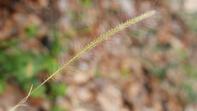
Cats Tail
Name
Cat’s tail grass, bottle-brush or rainbow grass (Perotis patens)
Description
This plant is an annual that reaches up to 60 cm in height with 12 mm leaf blades. Its inflorescence is a rigid, straight, soft spike. The spikelets are small and each has two awns, and its leaves are curvy and a bluish-green in colour. Cat’s tail grass is seldom grazed upon, as it is unpalatable.
Habitat
In South Africa, cat’s tail grass can be found growing in Limpopo. It grows in compacted, nutrient poor and sandy soils – often in disturbed environments. It can also be found in orchards, cultivated land and rocky scarps.
Flowers
This grass flowers from November to April.
Uses
Cat’s tail grass is not often grazed because of the few leaves it carries. It sometimes occurs as a weed in disturbed places. This grass is easy to control mechanically and its inflorescence is sometimes used in flower arrangements.
Field Notes
Cat’s tail grass is known by different names in different locations. It is known as bottlebrush grass, rainbow grass and purple spike perotis, too.

